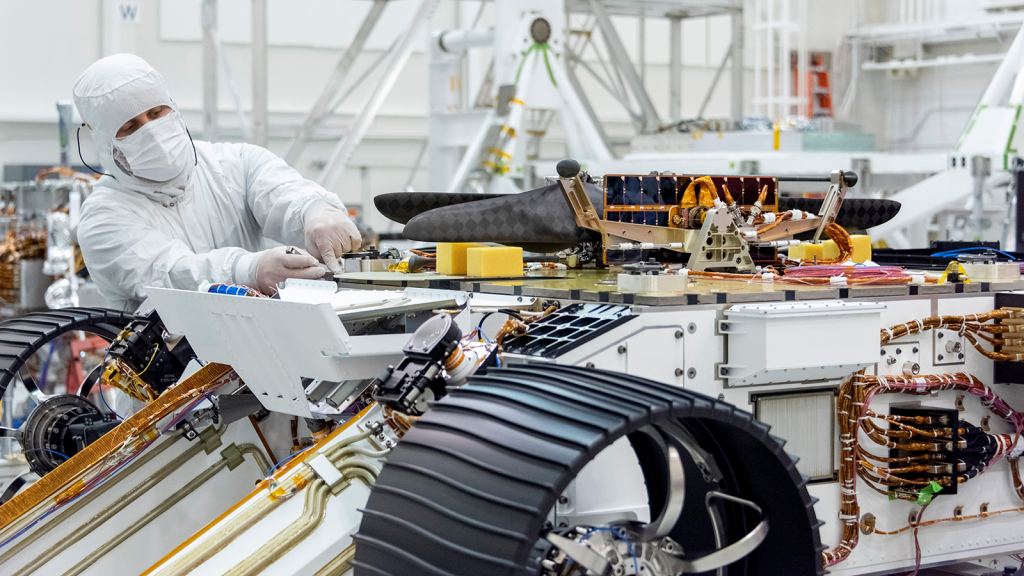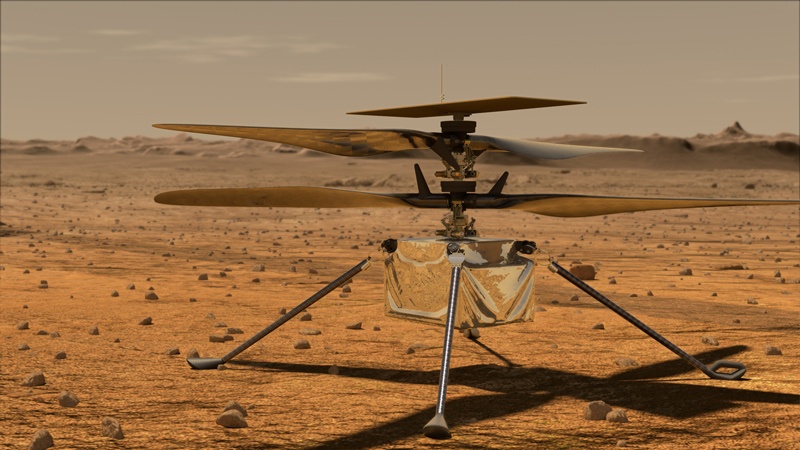Flying low over the surface of Mars. Don’t tell me you haven’t dreamed about it, especially with some of the ‘Mars flyover’ videos that have been produced over the years using data from the orbital missions. And if all goes well – global pandemic not withstanding — a helicopter will be on its way to the Red Planet in just a few months.
NASA’s Mars Helicopter will ride to along to the Red Planet attached to the belly of the Mars 2020 rover, Perseverance, currently scheduled for launch in July or August of this year. The helicopter will be the first aircraft to fly on another planet. It’s a little guy – the small rotor-craft only weighs 1.8 kg (4 lbs.) and is made of lightweight materials like carbon fiber and aluminum.
And since the rover recently got the name Perseverance, NASA thought it was only fitting the helicopter have a name, too. NASA and JPL announced that Vaneeza Rupani, a junior at Tuscaloosa County High School in Northport, Alabama, came up with an apropos name: Ingenuity. She wrote of her reasons for suggesting the name in submission to NASA’s “Name the Rover” essay contest.
“The ingenuity and brilliance of people working hard to overcome the challenges of interplanetary travel are what allow us all to experience the wonders of space exploration,” Rupani wrote. “Ingenuity is what allows people to accomplish amazing things, and it allows us to expand our horizons to the edges of the universe.”
Rupani’s was among 28,000 essays submitted to NASA by K-12 students from every U.S. state and territory recommending names for the next Mars rover. In March, the agency announced that seventh-grader Alexander Mather’s essay earned him the honor of naming the rover Perseverance. But NASA felt they had received so many great essays for naming the rover, it seemed fitting to also choose a name for the helicopter accompanying the rover. NASA officials went back to the submitted essays to choose a name for the helicopter. Thomas Zurbuchen, associate administrator of NASA’s Science Mission Directorate, made the choice for the rover’s name, and NASA Administrator Jim Bridenstine chose the name for the helicopter.
Since the helicopter is a secondary mission, it won’t be flown right away. After the landing in Jezero Crater in February of 2021, Ingenuity will remain encapsulated in a protective cover to shield it from debris during entry, descent and landing. When the timing in the rover mission is right (i.e., if everything is going well for Perseverance), Ingenuity will be deployed to first stand and then operate autonomously on the surface of the Red Planet. It is impossible to do real-time flight operations from Earth, due to the long-distance delay time in radio communications. The solar-powered craft – built from a combination of specially designed components and off-the-shelf parts – will be checked out and then perform a test flight.

If successful during its 30-Martian-day (31-Earth-day) experimental flight test window, and if the little ‘copter proves that powered flight can be achieved at Mars, it will enable future Mars missions to better utilize second-generation helicopters to add an aerial dimension to their explorations, NASA said.
“In the early days of this project, the feasibility of flying at Mars was questioned,” said MiMi Aung, Mars Helicopter project manager at JPL. “But today we have a helicopter down at the launch site, installed on the rover and waiting to board the rocket which will carry us to the Red Planet. Like Vaneeza said in her essay, ingenuity and hard work led us to see beyond what was logical to what was possible. Now Ingenuity will have its chance to fly at Mars.”
The helicopter is largely a technology demonstration mission, so the overall mission for the Mars 2020 rover won’t depend on the helicopter, but NASA hopes to learn a lot about how to proceed with aircraft on future missions by putting the Mars helicopter through its paces on Mars.
The helicopter successfully completed its flight-testing program using the 25-foot space simulation chamber at NASA’s Jet Propulsion Laboratory in Southern California. The next flight attempt will be the real deal: in the actual environment of Mars. And if Ingenuity encounters difficulties, engineers will apply the lessons learned to future technology demonstrations. The science-gathering portion of the Mars 2020 mission will not be impacted.
Read more about the Ingenuity Mars Helicopter in our previous here and here, or at NASA’s website.

